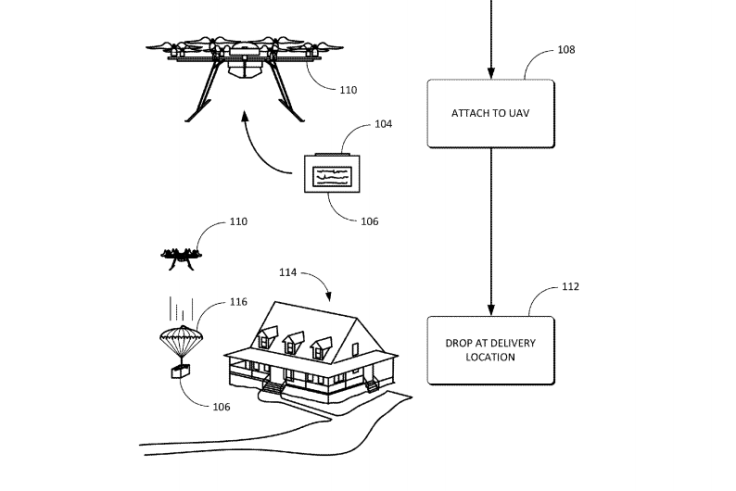Amazon Granted Patent For Drone-And-Parachute Delivery System
Amazon could drop off your package using a drone and parachute, a patent found by GeekWire shows.
The patent, titled "Aerial Package Delivery System," was filed on Aug. 26, 2015, and was granted this week. The documents show Amazon is trying to safely deliver your purchased items using a drone without damaging them.
Read: Prime Air Pilots Protest Work Conditions Outside Amazon Shareholders Meeting
“The system can comprise a label that includes a parachute to enable the packages to be dropped from the aerial vehicle, yet land at the package’s destination without damage,” the patent says.
Here’s a photo of the drone and parachute delivery included in the documents:

Amazon’s system would include a self-adhesive backing, multiple parachute cords, a parachute and a breakaway cover, the documents say. The parachute cords would keep packages from being damaged by using a shock absorber. The parachute and/or breakaway cover could also include graphics and text to include an address, velocity and spin information about the delivery. The system could also come with a harness to prevent cords from tangling as the package descends.
Read: DJI's New Spark Camera Drone Weighs Less Than A Can Of Soda, Controlled By Hand Gestures
Amazon announced in 2013 it was planning to deliver goods by drone. Last December, the online retailer conducted its first drone delivery trial in Cambridge, England.
Amazon CEO Jeff Bezos said the company’s Prime Air drone service would deliver packages in 30 minutes or less after customers placed an order. Amazon did not specify when the delivery service using small drones would begin.
“We will deploy when and where we have the regulatory support needed to safely realize our vision,” Amazon said at the time. “Prime Air has great potential to enhance the services we already provide to millions of customers by providing rapid parcel delivery that will also increase the overall safety and efficiency of the transportation system."
Amazon said it was gathering data from its Cambridge trial to improve the safety and reliability of the system. The company added it was testing different drone designs and delivery mechanisms to pick out what works best for packages and customers in multiple environments.
Amazon has Prime Air development centers in the U.S., U.K., Austria and Israel. The company said it was working with regulators and lawmakers in other countries so it could conduct similar trials in other nations.
The retailer isn’t the only company looking at drone deliveries for packages. UPS said earlier this year it had successfully tested a drone for residential delivery to help reduce emissions.
The drone was launched from the top of a UPS vehicle and autonomously delivered a package to a home in Tampa, Florida. The drone then returned while the delivery driver was en route to another delivery. UPS used a drone built by Workhorse, which has a 30-minute flight time and can carry packages weighing up to 10 pounds.
© Copyright IBTimes 2025. All rights reserved.



















